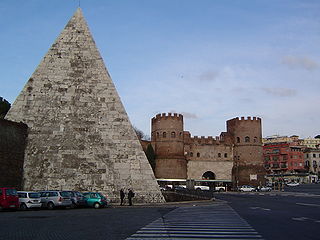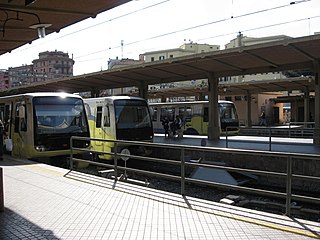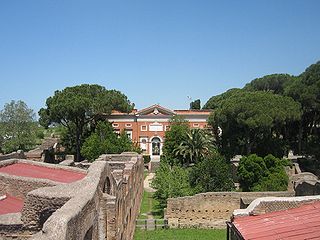
Fiumicino is a town and comune in the Metropolitan City of Rome, Lazio, central Italy, with a population of 80,500 (2019). It is known for being the site of Leonardo da Vinci–Fiumicino Airport, the busiest airport in Italy and the tenth-busiest in Europe.

The Rome Metro is a rapid transit system that operates in Rome, Italy. It started operation in 1955, making it the oldest in the country.

The city of Rome, Italy is divided into first-level administrative subdivisions.

Testaccio is the 20th rione of Rome, identified by the initials R. XX, deriving its name from Monte Testaccio. It is located within the Municipio I.

The Porta San Paolo is one of the southern gates in the 3rd-century Aurelian Walls of Rome, Italy. The Via Ostiense Museum is housed within the gatehouse. It is in the Ostiense quarter; just to the west is the Roman Pyramid of Cestius, an Egyptian-style pyramid, and beyond that is the Protestant Cemetery.

Portus was a large artificial harbour of Ancient Rome. Sited on the north bank of the north mouth of the Tiber, on the Tyrrhenian coast, it was established by Claudius and enlarged by Trajan to supplement the nearby port of Ostia.

Ostia Antica is the 35th zona of Rome, Italy, four kilometers away from the coast. It is identified by the initials Z. XXXV and it is distinct from Ostia. Ostia Antica belongs to Municipio X.

Ostia is a large neighbourhood in the X Municipio of the comune of Rome, Italy, near the ancient port of Rome, which is now a major archaeological site known as Ostia Antica. Ostia is also the only municipio or district of Rome on the Tyrrhenian Sea, and many Romans spend the summer holidays there.

The Roma–Lido railway is an urban railway line connecting the Porta San Paolo Station in Rome to Lido di Ostia, Rome's seaside neighborhood. The railway is 28.3 km (17.6 mi) long, stops at 13 stations and carries on average over 90,000 passengers per day.

Roma Ostiense is a railway station in Piazza dei Partigiani serving the Ostiense district of Rome, Italy, a short distance from the Porta San Paolo. It is run by the Rete Ferroviaria Italiana arm of the Ferrovie dello Stato Italiane group and the urban rail lines FR1, FR3, and FR5 run through the station. It is linked with the Piramide Metro B station and the Roma Porta San Paolo station on the Rome-Lido railway line.

EUR Magliana is a railway station in Rome served by the Metro line B and the Ferrovia Roma-Lido in the EUR or Europa district of Rome. It was opened in 1924 as a Roma-Lido station for the Esposizione Universale Roma as Magliana. It was later renamed Magliana Ostiense, then Magliana again and finally its present name.
Ficana was an ancient city of Latium, which figures in Roman history only on the occasion of its conquest by Ancus Marcius, who is said to have moved the inhabitants to Rome, and destroyed the city itself. It is certain that it was never repeopled: its name is found in Pliny's list of the extinct cities of Latium, and is noticed also by Festus as a place no longer in existence. The latter passage, however, affords us a clue to its position; according to Marcus Antistius Labeo there cited, it was situated on the Via Ostiensis, eleven miles from Rome, and apparently immediately adjoining the Tiber, on which it had a port, at a place called by Fabius Pictor the Puilia Saxa. The city's site is in the commune of Rome near Acilia, on the via Ostiense between Rome and Ostia.

Roma Porta San Paolo is the terminal train station of the Rome–Lido railway line in Rome (Italy). The station is connected to the station Piramide of the metro and to the Roma Ostiense railway station of the Ferrovie dello Stato Italiane. It has six tracks.

Municipio I is an administrative subdivision of the municipality of Rome, encompassing the centre of the city.

Via Cristoforo Colombo is a street in Rome (Italy) that links the historic centre to Ostia. Along most of its route, the street has three lanes for each direction of movement. With its 27 kilometres (17 mi) length it is the longest Italian road among those included within the borders of a single municipality and, in several stretches, the largest in Italy.

Ostiense is the 10th quartiere of Rome, identified by the initials Q. X.

The Museo Archeologico Ostiense is an archaeological museum dedicated to the ancient Roman city of Ostia in Rome, Italy.

ATAC S.p.A. is an Italian publicly owned company running most of the local public transportation services, paid parking and incentive parking lots in Rome. More specifically, the company handles, on behalf of Roma Capitale Authority, the entire tramway, trolleybus network and metro lines, as well as most of the bus lines in the city. It also operates, on behalf of the Administrative Region of Lazio, three railways: Roma-Civita Castellana-Viterbo, Roma-Giardinetti and Roma-Lido. ATAC S.p.A., with its 2,200-kilometer-wide public transport network, its over 8,500 busses and 70,000 parking stalls, is currently one of the biggest public transportation companies in Europe and the largest in Italy.

Municipio Roma III is the third administrative subdivision of Rome (Italy).

Municipio Roma VII is the seventh administrative subdivision of the Municipality of Rome (Italy).




















